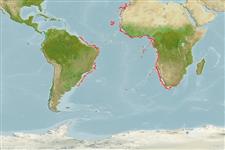Classification / Names
Common names from other countries
Main reference
Size / Weight / Age
Max length : 121 cm TL male/unsexed; (Ref. 26346)
Length at first maturity
Lm ?, range 100 - 104 cm
Environment
Marine; bathydemersal; depth range 100 - 1500 m (Ref. 26346)
Climate / Range
Deep-water, preferred 25°C (Ref. 107945); 35°N - 41°S, 82°W - 177°W
Distribution
Atlantic, Pacific and Indian oceans. Western Indian Ocean: from off the Seychelles to the Madagascar Ridge and South Africa. Eastern Indian Ocean off Indonesia and southwestern Australia. Southwestern Pacific: off Australia, New Caledonia and New Zealand. Northwestern Pacific: off Japan and from the Hawaiian-Emperor seamount chain. Southeastern Pacific: west of Chile. Southwestern Atlantic: off French Guiana, Brazil, and Uruguay. Northwestern Atlantic: Gulf of Mexico. Eastern Atlantic: from off the Azores in the North to off South Africa in the south.
Countries | FAO areas | Ecosystems | Occurrences | Introductions
Short description
Anal
spines: 0;
Anal
soft rays: 0. Dark brown or black in color, dorsal fins with extreme tips of fin spines protruding from the fins, moderately long snout, lanceolate upper teeth and bladelike lower teeth with short, oblique cusps, fairly stocky body that does not taper abruptly from pectoral region, large lateral trunk denticles with mostly smooth, circular, cuspidate and acuspidate crowns in adults and subadults (Ref. 247).
IUCN Red List Status (Ref. 115185)
Threat to humans
Poisonous to eat (Ref. 6871)
Human uses
Fisheries: minor commercial
More information
ReferencesAquacultureAquaculture profileStrainsGeneticsAllele frequenciesHeritabilityDiseasesProcessingMass conversion
Tools
Special reports
Download XML
Internet sources
Estimates of some properties based on models
Phylogenetic diversity index
PD50 = 0.5313 many relatives (e.g. carps) 0.5 - 2.0 few relatives (e.g. lungfishes)
Trophic Level
4.5 ±0.62 se; Based on food items.
Resilience
Low, minimum population doubling time 4.5 - 14 years (Fec=16-28)
Vulnerability
High vulnerability (64 of 100)
Price category
